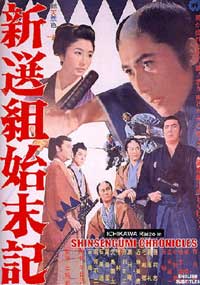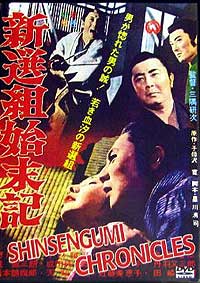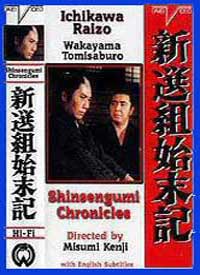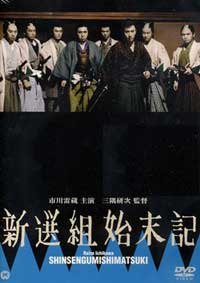A rousing adventure builds in Shinsengumi Chronicles: I Want to Die a Samurai (Shensengumi shimatsuki, Daiei, 1963), which I first saw on a big screen in a faded 35 mm print, which is now available on DVD from a new digital master.
 It stars Raizo Ichikawa, Tomisaburo Wakayama (credited by his earlier name Kenzaburo Jo), Raizo's recurring leading lady Shiho Fujimura, Katsuhiko Kobayashi, Shigero Amachi, & Kinshirou Matsumoto. It is the story of the controversial Shinsen Group at the end of the feudal age, whose history provides one of the most often filmed themes in chambara. It stars Raizo Ichikawa, Tomisaburo Wakayama (credited by his earlier name Kenzaburo Jo), Raizo's recurring leading lady Shiho Fujimura, Katsuhiko Kobayashi, Shigero Amachi, & Kinshirou Matsumoto. It is the story of the controversial Shinsen Group at the end of the feudal age, whose history provides one of the most often filmed themes in chambara.
Some versions depict Shinsengumi as a wonderful egalitarian club wherein even farmers can become samurai & old values never end. Other films portray them as vile, sadistic killers who could not abide change. Kenji Mizumi's 1963 version takes a half-way position, being based on a novel by Zatoichi's creator Shimazawa Kan. Kan deeply researched Shinsengumi & even interviewed living descendants of the group's members. When Raizo Ichikawa saw the script, he was overwhelmed by its excellence, & quit the film he'd been working on so as to be part of what he perceived would be a great film.
Idealistic young samurai flock to join Shinsen Group in the fight against loyalists, circa 1863, as the Tokugawa shougnate struggles against inevitable collapse. Unfortunately, the captain of the group, a hatamoto or banner man of the Aizu clan named Serizawa, is given to abuse of power. Thus Shinsen Group is soon known as "the wolves."
One of Serizawa's founding lieutenants is an ex-farmer named Isami Kondo. Some believe Tomisaburo Wakayama's performance is the closest anyone has ever gotten to capturing the complex character of the historical Kondo. Kondo is an admitted "stickler" for samurai codes, because of his low-born origins. Though a master fencer, Serizawa calls him "clod-hopper" & other names; but stickler that he is, Kondo remains obedient to the cruel captain.
Kondo's aide, Hijikata, is of the merchant class, but has also become a samurai. He does not want personal fame, but is a machievellian manipulator pushing ex-farmer Kondo up the ladder of success. When Serizawa's closest right-hand-man is found guilty of extortion, Hijikata insists on the man performing harakiri. If Serizawa won't command it, according to Hijikata that would prove collusion. Thus has Hijikata gotten rid of the main opponent to Kondo's rise.
Later Serizawa himself is judged guilty of molesting a married woman & Hijikata leads a successful assassination. Having Kondo thereafter in charge would seem to be an improvement. Despite Hijikata's machinations, Kondo is not at heart wicked; & for a while, Shinsengumi is no longer considered "the wolves." Still, although Kondo is charismatic & well-meaning, he is far too easily manipulated by his long-time friend & aide.
Not that Kondo is blind to his friend's manipulations. He has gained by them so doesn't mind very much. While in a jovial mood, he says during a private interlude with Hijikata, "I'm just a figurehead, eh?" Hijikata admits it, but adds half-seriously, "Yet, somehow I am afraid of you."
The loyalists, supported by the Choshu clan & others, plan a riot during Gion Festival in Kyoto, which Shinsen group will successfully abort in a final battle sequence, insuring Kondo's status in the city. The final encounter inside & outside the inn & on the surrounding rooftops -- royalists being destroyed by only seven Shinsen men -- is a surperb job of editing & choreography, closing with an ironic "still life" of bloody corpses while birds sing in the gardens outside. Cinematographer Shozo Honda's photograhic arrangement is gorgeous & grim.
 With surprising depth of chracter we are shown the corruption of key Shinsengumi figures on their rise to power; but they are heros nonetheless & do succeed in many of their primary goals. With surprising depth of chracter we are shown the corruption of key Shinsengumi figures on their rise to power; but they are heros nonetheless & do succeed in many of their primary goals.
The film is rather unique in that the star of the film, Raizo Ichikawa, is not the motivating factor of the plot, though he has a position in most of the events. When Raizo originally came on board the project it was argued whether his role should be expanded & made more central, but he was not an egoistic star, & insisted the script was too good to be tampered with.
His character is Susumu Yamazaki, a ronin & superior fencer. He joined Shinsen Group though disliking the corrupt captain, for he had been impressed with Kondo.
As events unfold, he acts as witness to the machinations of the sinister Hijikata, including the cowardly assassination of the corrupt leader. When all of Shinsen group is motivated by Hijikata to make Kondo the new leader, only Yamazaki is unmoved; only he sees fully what has happened. And because of this, Hijikata believes that Yamazaki is his enemy & tries to have him destroyed, though by the end he realizes Yamazaki has always been a man to be trusted.
When Yamazaki is his most disillusioned, his girlfriend (Shiho›Fujimura) remarks, "Your eyes were sparkling when you wanted to join. Now they are dull." But ultimately he holds his faith in Kondo & it pays off in the end, not without bittersweetness.
There are decorative touches to the film adding a great deal of texture. Western influence is seeping into Kyoto, enough that when Yamazaki forgives the traps set by Hijikata & his henchman-lover (Hijikata's homosexuality is underplayed but specific), they make up with Western handshakes, which would have been an anachronism in any earlier period. Yamazaki's girlfriend wants to study Dutch medicine (she wants to be a doctor but the script unfortunately gives her nothing much to do beyond scream at the sight of blood).
 In a hilarious scene, Kondo is having his picture taken (something he finds excruciating) while the photographer counts off, in English, "One, Two, Three." These touches of Western influence are subtle reminders that the rebellions portrayed in the story stem in great part from the outside influence of Admiral Perry's "Black Ships" & the beginning of Japan's opening its ports to foreign trade. In a hilarious scene, Kondo is having his picture taken (something he finds excruciating) while the photographer counts off, in English, "One, Two, Three." These touches of Western influence are subtle reminders that the rebellions portrayed in the story stem in great part from the outside influence of Admiral Perry's "Black Ships" & the beginning of Japan's opening its ports to foreign trade.
The film's first English title I Want to Die a Samurai was corny yet a viewer can get into the sentiment very easily. Kondo, once a peasant, Hijikata, once a traveling salesman, & the ronin Yamazaki . . . all have sought what is whimsically translated in the subtitles as "Samuraihood." Kondo's severe adherence to samurai ethics, & Yamazaki's desire to serve a master of such strong conviction, is reflected more overtly in the side-story about Hikobei, the fifteen year old farmboy who dreamed of joining Shinsen Group.
Hikobei had no skill with sword & was rejected, but Kondo interceded, remembering that he, too, was a farmer's son. Soonafter, the boy is modelling his new hakama trousers & wearing his swords; his happiness is infectious.
Yamazaki takes the boy under his wing. Later, Yamazaki & the boy pose as "peasants" which of course the boy really is, in order to get information about royalists. When the boy is killed -- a predictable happening, but still a successful tearjerker -- his last words are, "I wanted to die in a samurai outfit."
Despite what it loses in translation, it is unbearably sad. He had with him a block-print of a famous warrior, now all smeared with his own blood. Yamazaki is troubled to have witnessed this sorry event, but not quite detached enough to see the folly not just of this child's dream but every character's dream to be a samurai.
Perhaps at that moment Yamazaki regretted his actions in an early sequence of the film, where a wounded samurai begs succor & Yamazaki offers a coup de grace instead of helping the man live. Yet in the end, Yamazaki, Kondo, & even the morally suspicious Hijikata & his pretty henchman-lover are rewarded for their efforts. That Yamazaki's girlfriend is left behind & a dreaming boy's life is spilled on a block-print . . . well, it is part & parcel with the dream of "samuraihood." A foolish dream, but an inescapable one for many of the film's characters.
copyright © by Paghat the Ratgirl
|

